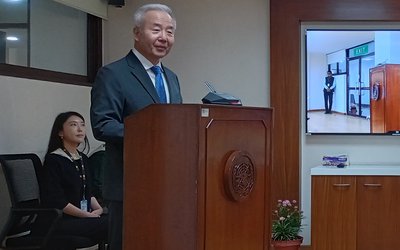
As the pace of reconstruction takes off, there is a short supply of construction materials in various parts of the country. At a time when there are a lack credible reports and studies regarding the demand and supply of materials, Practical Action South Asia offers a solution.
When other agencies are focusing on reconstruction, Practical Action focuses study on demand and supply sides of the construction materials required to accelerate the drive.
In a study conducted by Practical Action in Rasuwa and Nuwakot under Supply Chain Management of Construction Materials in Earthquake Affected Districts reveals the huge gaps demands and supply sides. Started in June 2016, the project will continue till May 2018 including 4 months inception period.
“Above 650 thousand houses in 14 most affected
districts are awaiting/undergoing reconstruction. However, smooth availability
and affordability of reconstruction materials still remain uncertain. While
demand and supply gap of the construction materials is alarming, a robust
supply chain management strategy seems to be the utmost priority at present
context to reduce gap and create smooth environment for supply of construction
materials. Practical Action conducted an assessment of overall demand and supply
situation of reconstruction materials in Nuwakot and Rasuwa Districts,” said
Achyut Luitel Regional Director, Practical Action. “The study has identified
major issues around the construction materials and recommends probable measures
to address the issues.” 
“Besides, demand and supply gap, ensuring the quality of the construction material is a major concern. Majority of households are ignorant about the quality of the local materials. The influx of the substandard non-local materials during the relief phase has also raised concern regarding the quality of non-local materials,” said Practical Action’s report.
The 2015 earthquake caused widespread destruction in Nepal. About 650,453 houses in 14 most affected districts need reconstruction (CBS, 2016). Reconstruction of the houses and the community infrastructures require massive amount of the construction materials. A study carried out by Practical Action shows that there is huge demand between the supply and the demand of the construction more. The gap is more pronounced in local materials like sand, aggregate and timber.
Funded by the UK Aid from the UK government, the study team includes Dr. Sujan Piya, Rabindra Bahadur Singh, Chhabin K Magar, Trishakti JB Rana and Prof. Dr. Devendra Bahadur Chhetry.
According to the study, there is a demand of 21.19 million Metric tons of local materials like stone but the supply is just 15.6 metric tons. Similarly, there is a demand of 6.43 million metric tons of sand, supply is 2.28 million metric tons. The demand of aggregate is 2.43 million metric tons and supply is 0.58 million metric tons. Wood is 4.64 million metric tons in demand and supply is 2.56 million metric tons.
Similarly, there is a huge gap in supply of non-local materials like cement, brick,CGI Sheet and Reinforcement.
With an aim to help, NRA to replicate the project success cases in other districts, Practical Action studied 50 thousand households in Nuwakot and Rasuwa districts providing advisory support at the National level. Objective of the study is to strengthen supply chain of construction materials with an output to reduce demand and supply gaps, improved quality, reduced price and improved coordination.
The high price of construction materials is another
cause of concern for the non-local materials. The production cost of the
materials is already high due to high dependency on the imported raw materials,
shortage of skilled labors and the power shortage. On the top of it, the
transaction cost is huge. A bag of cement which cost NPR 630 at the factory at
Birgunj is sold at NPR 890 at rural VDC of Nuwakot. The exorbitant
transportation fare is the major contributor for the transaction cost.
To address the above constraints, Practical Action has been implementing an UKaid funded project, on strengthening the supply chain of the construction materials. The project aims at ensuring the timely availability of the quality construction materials at the competitive price. It has been mobilizing the local cooperative for aggregating the demand for construction materials from the house owner and collective procurement of the materials on their behalf.
The early results show that the earthquake victims can save 8-12% of the cost ( about Rs, 90,000 per house) by the demand aggregation. In the normal market, the construction materials change hands seven times, before reaching to the customers. By aggregating the demand, the consumers have direct access to regional suppliers or factories, which has resulted in reduction in the transaction cost.
For reducing the stress on the conventional materials and providing the poor households affordable alternatives, the project is promoting alternative construction materials. Compressed Earth Block (CSEB) is one of such alternative materials. It constitutes local earth, sand and small quantity of cement ( 10%). It cost less the fired bricks and require less labor and cement mortar to build house with. Per m2 of wall build with fired brick cost around Rs 3500 whereas it cost about half ( Rs 1900) with CSEB.
Likewise, it has been introducing simple technologies like stone cutting machine and wood treatment plants for improving the quality of the construction materials. A simple stone cutting machine, which cost around Rs 120,000 reduce the cost of through stone/corner stones by more than half. Through stones and corner stones are mandatory in the government approved stone masonry buildings. A labour can prepare maximum 6 corner/through stones in a day manually. The machine can produce up to 200 pieces of corner stones.
A simple one story house requires more than 150 corners and through stones, which would cost around $ 300, if prepared manually. However, with the machine, the cost can be reduced to $ 100. The treatment plants help to improve the strength of the locally available woods.
As the reconstruction picks speeds, ensuring the quality of the construction material at the competitive price is going to be major challenges. Hence, Government /National Reconstruction Authority (NRA) require a robust strategy, to address the challenges. The results and learning of the project, can help the government to formulate the strategy.
The study indicates change in peoples’ preference of building types following the earthquake. However, the stone masonry in mud mortar is likely to continue to be the predominant building type for reconstruction. About 55 per cent households are planning to construct stone masonry building in mud mortar. Before the earthquake, more than 80 per cent of the buildings were stone masonry in mud mortar. Another, 12 per cent are planning to build stone masonry building in the cement mortar. About 26.4 per cent buildings are likely to be the brick masonry in cement mortar.
However, the figure varies, with the accessibility of the areas. In accessible areas, majority of houses (52%) are likely to be brick masonry in cement mortar. On the other hand, in accessible areas, more (79%) are likely to be stone masonry in mud mortar. Corrugated Galvanized Iron (CGI) sheet is the most popular roofing materials irrespective of the areas with 81per cent of households preferring it.
- IME GROUP: Expands Into Paper Industry
- Mar 24, 2025
- CPN UML: Instigated By India
- Mar 23, 2025
- ADB’S CHIEF ECONOMIST: Nepal Reduces Poverty
- Mar 11, 2025
- FM DR. DEUBA: A Successful Visit
- Mar 11, 2025
- MD GHISING: Target Of Personal Grudge
- Mar 09, 2025















